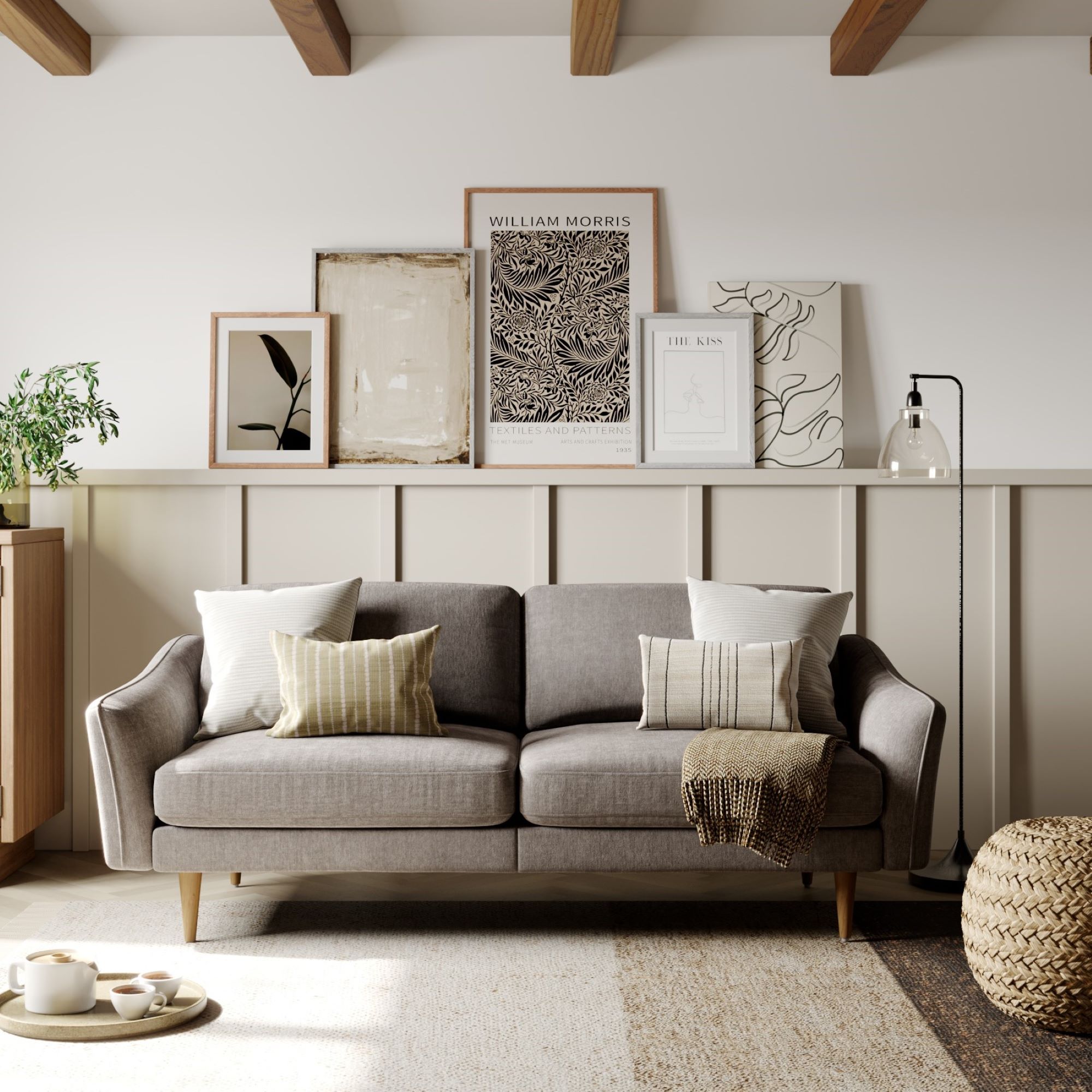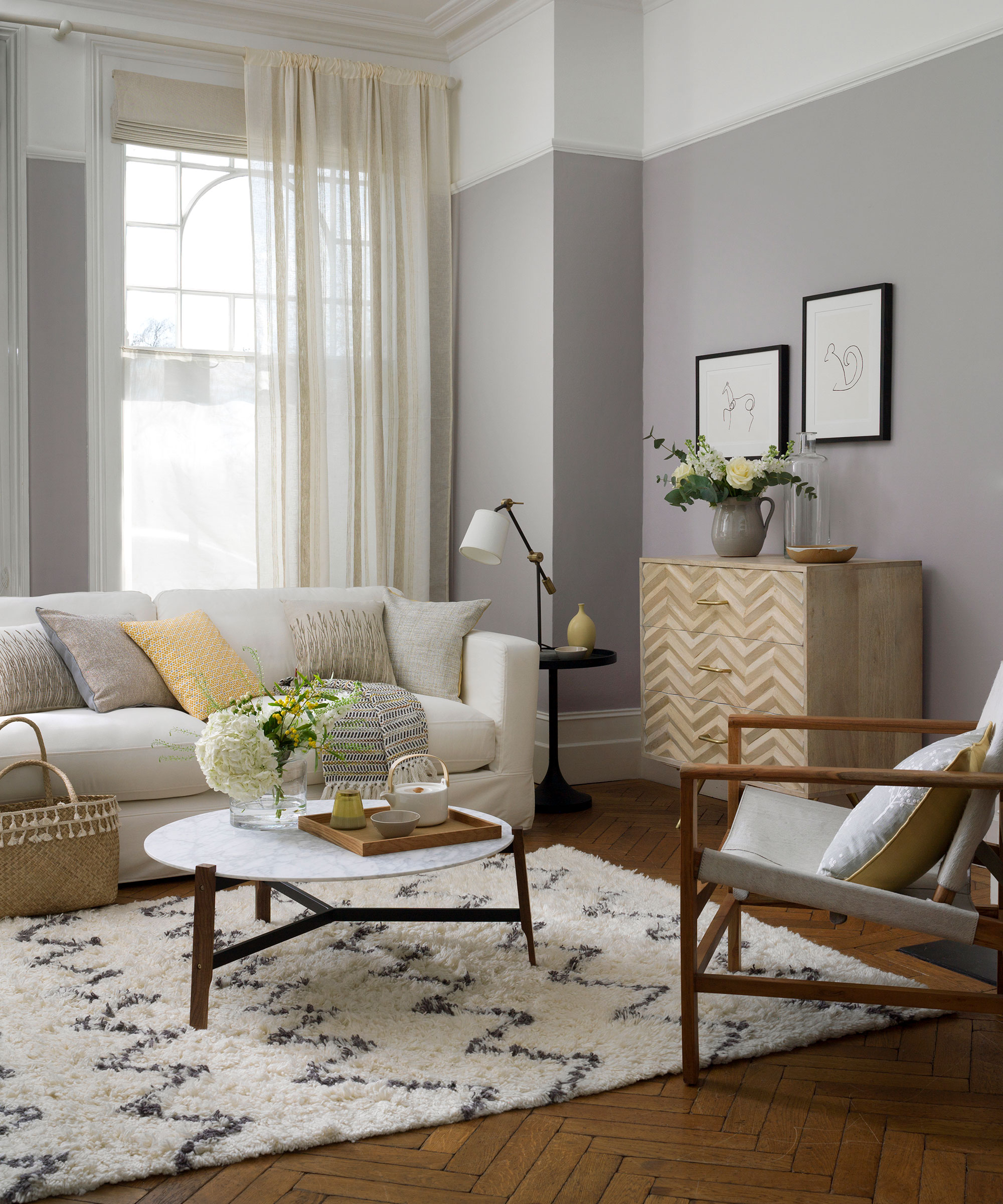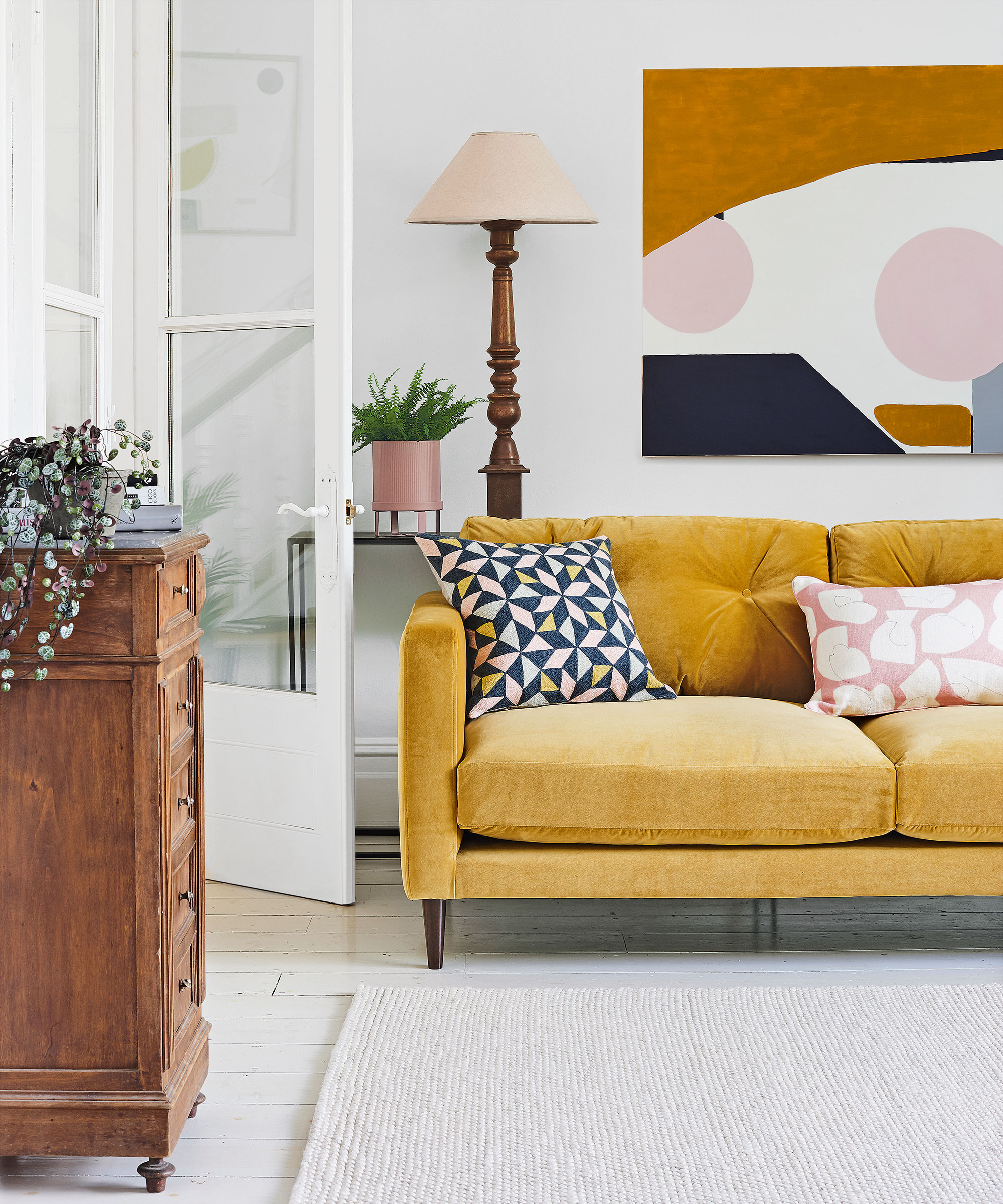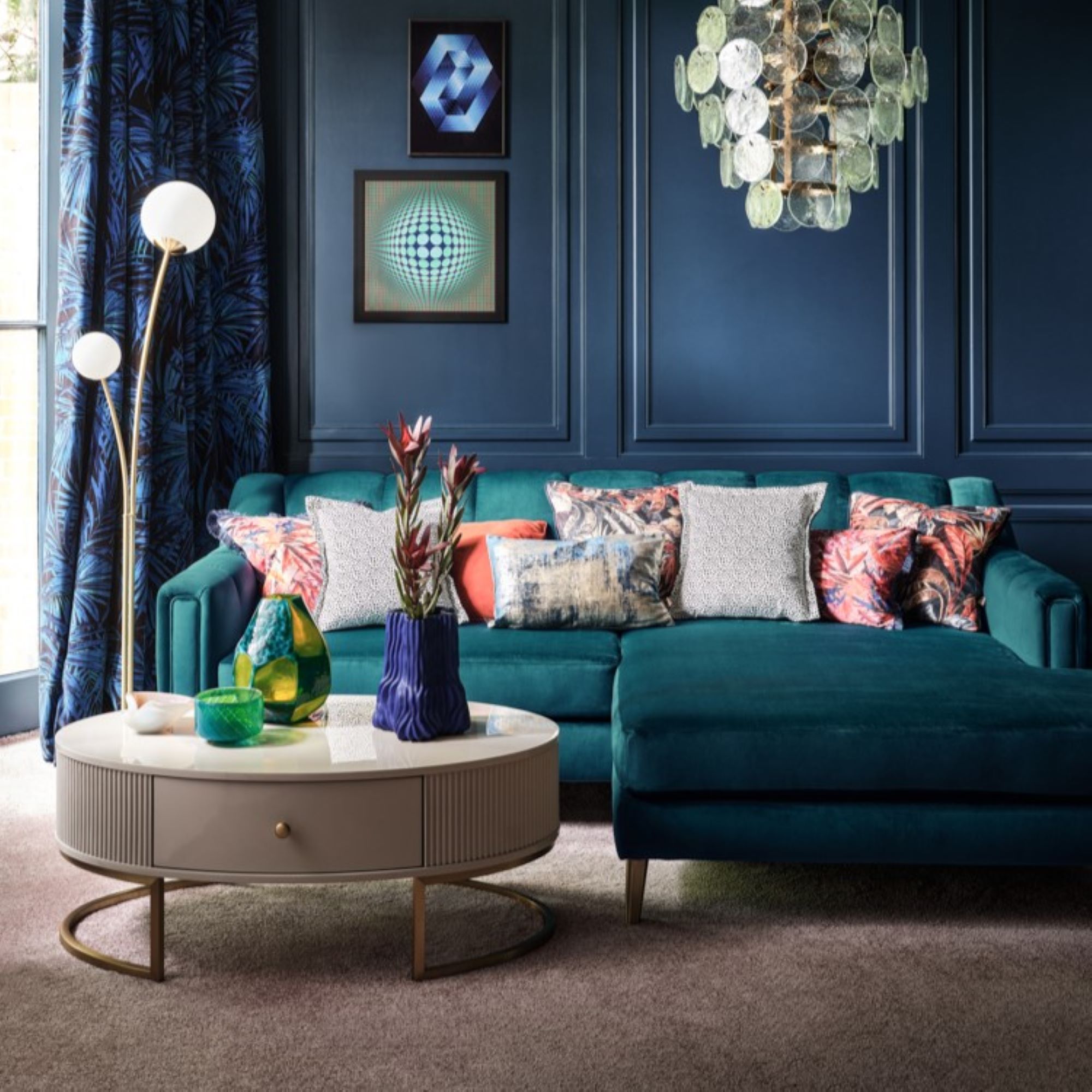How to measure for a sofa - experts share their tips to find the perfect sized sofa
Follow our handy guide to ensure your new sofa fits perfectly in your home

Katie Sims

The sofa is arguably the most important piece of furniture in the home, and not just because it's the biggest. We spend a lot of time on the sofa (probably more than we like to admit) so it's absolutely essential that we learn how to measure for a sofa so that we can get the perfect one for our home.
Finding the best sofa is no easy feat; there are so many styles and colours to choose from, it can feel a little overwhelming when shopping for one. But whatever style you end up landing on, the correct size is a non-negotiable as it can make or break for your living room sofa ideas.
Kellie Wyles, Head of Upholstery and Brand at DFS says, 'Measuring for your sofa is an important step in the sofa decision-making process. It’s not a case of simply getting the tape measure out, but also about considering what works best for a space, how it will look visually and work logistically.'
Not only does your sofa have to fit your desired space perfectly, but it's also got to get through the door - and possibly up the stairs and round tight corners first. The last thing you want to do is order a sofa online and have it turn up far bigger or smaller than you expected. This might make an amusing anecdote one day, but it will cause us a lot of stress in the meantime, not to mention some precious money.

How to measure for a sofa
So you can avoid having a Ross from Friends moment (PIVOT!), we've asked the experts to share all their tips on how to measure for a sofa. Our guide will take you through everything you need to know, from thinking about the proportion of the sofa to the rest of the space, to how to get precise measurements.
1. Think about how you use the room

First things first, you need to choose a sofa that is right for you, so it helps to know how you currently use the space, or how you plan to use the space. There are plenty of sofas out there from grey sofa living room ideas to emerald green sofa living room ideas out there, so this should help to streamline your choices.
'Start by thinking about what your living room is going to be used for. Some people have separate living rooms from the rest of the house and a lot of us have knock throughs where it’s off the kitchen/diner, but whatever size of space it’s important to understand whether it’s a social place or if it’s a place for watching TV, or both,' says Charlie Marshall, Founder, Loaf.
Sign up to our newsletter for style inspiration, real homes, project and garden advice and shopping know-how
'Symmetry in a social or formal space will look great and the balance between sofas facing each other, or even a sofa and two armchairs, will be visually appealing. Introduce a large footstool or coffee table in the centre and some ambient lighting for an intimate feel. If it’s a family room then it’s likely that the sofa will be a main feature, and this could even be a large corner or chaise style.'
Kellie advises making sure you'll be giving your new sofa the space it deserves, even with small living room sofa ideas. 'Your first step should be to look at the room where you plan to put your sofa and consider what’s needed for the space.'
'Do you need a sofa that will fit into a snug corner or are you looking for a statement piece for the middle of an open plan room? Perhaps you would prefer a big, comfy, corner option for movie nights with the whole family! Once you’ve established this you can start to search for a sofa style that works with your space.'
2. Scope out the space

Next you need to get a feel for the space and take into consideration how much of the room will be left once the sofa is in.
'It’s always helpful to walk around the space where the sofa will be to check you can move around it comfortably,' says Kellie. 'This will help you ensure that you’ll still be able to open windows and doors when the sofa is in situ and move past any coffee or side tables. Similarly, take note of any nearby shelves or radiators to ensure the sofa height isn’t a problem.'
Charlies goes on to suggest, 'Always keep in mind how people will be coming in and out of the room and arrange the furniture accordingly as traffic flow is key. You don’t want any knocks or bumps and you don’t want any awkward weaving through the room. Aim to keep paths fuss-free and clear! Generally, you want lots of space! I’d say that walkways should be a minimum of 900mm and if it’s less than this then you’ll feel it.'

Patricia Gibbons from the Design Team at Sofa.com adds, 'The scale of your sofa is important. Too big and it can feel like it engulfs the whole room, too small you’ll be fighting over the best seat in the house. Finding that sweet spot is key.'
'Smaller rooms benefit from selecting sofas with slimmer proportions and sleek, clean silhouettes. Choose a model with elegant, tapered legs which raise the frame from the floor to give the illusion of more floor space. These larger scale pieces feel more statement and create an anchor to design around without overpowering a large living room. They also help zone, effectively acting as a room divider.'
3. Measure, measure and measure again!

So now comes the measuring part, which is imperative to ensuring you choose the right size sofa. All of our experts offer slightly different approaches of how to measure for a sofa, but they all agree, it's one you don't want to get wrong.
Dani Burroughs, Head of Product at Snug advises, 'To measure for your new sofa, it’s always a good idea to note the dimensions of the existing furniture. You’ll want to make sure your new sofa fits in the space without overcrowding - or underwhelming.'

'Another way to get a real sense of the size is to choose a style you like and map out its dimensions on the floor by laying out cardboard or taping an outline with masking tape. Play around with the different options: try sizing up or down until you find the perfect sofa that fits your home and style,' continues Dani.
Suzy McMahon, Buying Director at Sofology, suggests, 'Make sure you measure your room accurately and, if you have an existing sofa, use that as a benchmark to understand any differing dimensions of a new model. A good tip in an empty room is to lay down newspapers to help you visualise the footprint the sofa will use. Don’t forget that, when considering sizing, you’ll need to allow for leg room and space to move around the sofa.'
Patricia adds, 'Think about the amount of floor space you have and take a rough measurement of the maximum length and width the room can accommodate. It’s often difficult to visualise so if it helps, lay down a silhouette in newspaper or tape markers on the floor. You want to leave enough room to comfortably walk around the sofa and for other pieces of furniture.'
4. Consider access

So you know that your chosen sofa will fit once inside the room, but how about getting it there?
'Don’t just think about what the sofa will look like in the space, also think about how you’ll get it there in the first place,' says Kellie. 'There are lots of ways to work around tricky access, from sofas with bolt-on arms that can be fixed once your sofas are in place to smaller, modular pieces'
Suzy adds, 'Delivery is a key stage in the process of buying a new sofa, so make sure hallways and doors are wide enough to accommodate your sofa. To maximise space without compromising comfort, consider a corner sofa or chaise. Not only are they great for relaxing, their length serves as an integrated footstool that saves additional space in the room. Selecting a style with hidden storage can also help to make the most of a small room, negating the need for additional bulky furniture in the area.'
'Avoid unnecessary stress with a sofa that comes in a box and is ready to assemble in minutes without the need for DIY skills, heavy lifting or tools, ' adds Dani. All of Snugs sofas and sofa beds are delivered in a box, fit into awkward spaces and up winding staircases and are fully modular and re-configurable.
5. Get the layout of your room right

The next thing to do is ensure your new sofa sits correctly within your space.
Charlie advises, 'If it’s a large open plan area and you’re expecting plenty of traffic, you could look at zoning the space with open shelving. By creating a slight separation, you can keep the flow of the space without losing the cosy feel of the living room. Consider also using your sofa style to your advantage. Chaise and corner designs are an effective way to zone a space and offer walkways which will help the flow of the room.'
Suzy adds, 'Positioning the sofa against a wall will help to keep the room open, especially in a smaller space. A sofa’s proportions are particularly important in compact living. Opting for a petite sofa with a tall back and narrow arms will make the piece appear larger than it is, whereas choosing a corner sofa with a low back can help make a room feel bigger and the sofa less imposing.'
'Neutral sofas work well where space is limited, and can be kept up to date with cushions and throws in bold patterns and colours'.
How do I know what size sofa to buy?

'When you're buying a new sofa, you need to know more than just the measurements of your current sofa,' says Interior Designer, Rudolph Diesel. 'You'll also need to consider the size of your room, the layout of your space, and the number of people who will be using the sofa.'
It helps to measure the space where the new sofa will go, as well as your current sofa. 'Clear the room where your new sofa will go and measure the width and length of this space to figure out the maximum dimensions for your new living room suite,' says Francesca Hadland, Interiors Expert, Bridgman. 'To help you visualise how the sofa will sit, lay out paper templates in the shape of each piece of furniture to establish whether you can still comfortably move around the room.'
If it is too much of a faff to move your current sofa, you can just measure this instead and use these measurements as a guideline for what size sofa to buy. Interior designer Shanade McAllister-Fisher lays out the following steps for measuring your current sofa:
- First measure the length of your sofa by starting at one end and measuring to the other - make sure you're measuring along the longest side of the sofa.
- Now measure the depth of your sofa - start at the front of the cushions, and measure all the way to the back of the backrest.
- Make sure you also measure the width of the armrests - start at the outside edge of one armrest and measure to the outside edge of the other.
- When measuring the height of your sofa, it's best to measure both with and without the legs - you can never be too safe!
Do sofa measurements include the legs?

When measuring your sofa, take a measurement with the legs and without. The legs aren't essential to include, as they only affect the height. When sofa shopping, always double check if the measurements include legs or not.
'Sofa measurements usually include the legs, meaning if you're looking for seat height - the measurement from the floor to the top of the seat cushion where you'll be sitting - the dimension is taken with the legs of the sofa included,' explains Francesca at Bridgman.
'We recommend measuring from the floor to the top of the seat cushion,' says Jill O’Doherty, Design Consultant, Sofas & Stuff. 'Do remember, however, that in many cases, you might be able to take the legs off in order for it to fit through doors and small gaps when it first arrives.'

Holly Walsh is a freelance Interiors Writer and Shopping Editor, but worked in-house here at Ideal Home for nearly 10 years. With a background of studies in Interior Design, her career in interior journalism was a no-brainer and her passion for decorating homes is still as strong now 15 years after she started, as it ever was. While Holly has written for most of the home titles at Future, including Livingetc, Country Homes & Interiors, Homes and Gardens, Woman & Home and Style at Home, Ideal Home has always been her ideal home, and she can still be found sharing her expertise and advice across both the printed magazine and the website, while also raising her two young children.
- Katie SimsContributor